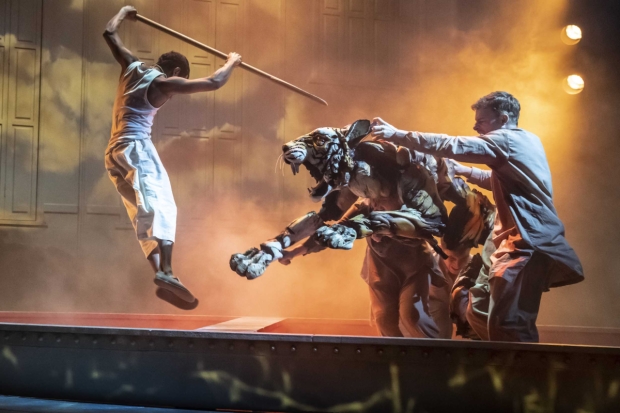Life of Pi review – a visual feast that leaves bigger questions unanswered

© Johan Persson
If you want theatrical magic, Life of Pi is the show for you. This stage adaptation of Yann Martel's Booker Prize-winning novel is an absolute feast of imaginative effects, bringing to life the apparently unstageable, with flair and jaw-dropping beauty.
It's the story of the wonderfully named Piscine Patel who grows up in a zoo. Driven out of his home in Pondicherry, India by the violence surrounding the state of emergency, he finds himself the sole survivor of a shipwreck, adrift on a small boat for 227 days – with only a Bengal tiger called Richard Parker for company.
In her stage version, Lolita Chakrabarti frames this adventure with Pi's meeting in a Mexican hospital in 1978 with an official from the Japanese Ministry of Transport who is trying to piece together why the ship sank and what happened next. So, the journey opens in a grey hospital room which is transformed when Pi starts to tell his story.
It's hard to overstate the wonder of that transformation. Puppet designers Finn Caldwell and Nick Barnes have created an entire menagerie of animals, both real and stylised. As Pi recalls his idyllic upbringing, they show us everything from brightly coloured butterflies that float by, to a giraffe poking its long neck through the window, to meerkats and the goat that is sacrificed as lunch for the tiger when the boy is taught a lesson about the savagery of the animal kingdom.

© Johan Persson
There's a vicious hyena, a motherly orangutan, huge zebras and finally the tiger himself, a magnificent creation whose every movement and sound make you believe you are in the presence of a dangerous prowling beast. The shipwreck and Pi's subsequent travails are equally vivid, as Tim Hatley's set produces – as if in a sleight of hand – a lifeboat and sets sail on a stormy sea, where each ripple and gleam of light is perfectly evoked by Andrezej Goulding's video projections and Tim Lutkin's lighting. Carolyn Downing's sound design creates an entire world.
It's a wonder and I wanted to love it whole-heartedly. Hiran Abeysekera is vigorous and astonishingly fleet-footed as Pi, scampering around the boat, taming the tiger, holding the stage with his storytelling and Max Webster's direction is skilful and assured. But for all the effort poured in, the evening doesn't quite float, remaining stubbornly anchored by a script that can't summarise the book's philosophical concerns without landing heavy lines such as "Man is the most dangerous animal" or "Faith is impossible in the real world".
The problem is compounded by the fact that apart from Pi, the surrounding human characters remain little more than ciphers. They wander on in his imagination to impart some knowledge and then walk off again. It is the puppets and the effects that are the stars.
But Life of Pi isn't really a tale of a boy and his growing bond with a tiger, it's a philosophical meditation on faith, doubt, and the actual nature of story itself, its power to shape the universe to what we want it to be. This production asserts the capacity of theatre to stage the unstageable and roots its pleasures in that. It doesn't address the bigger questions.










